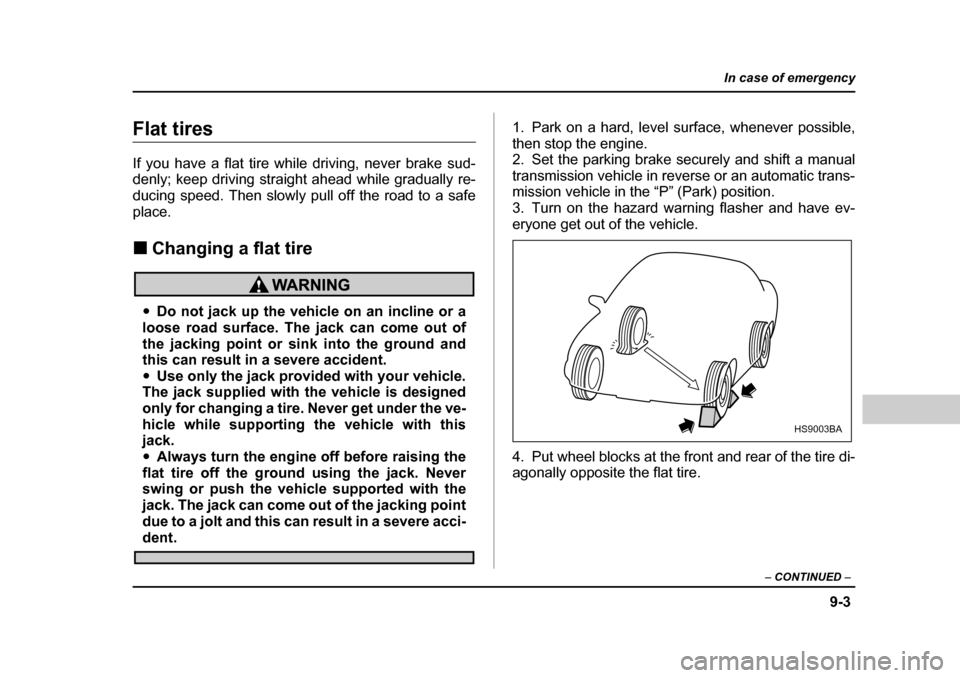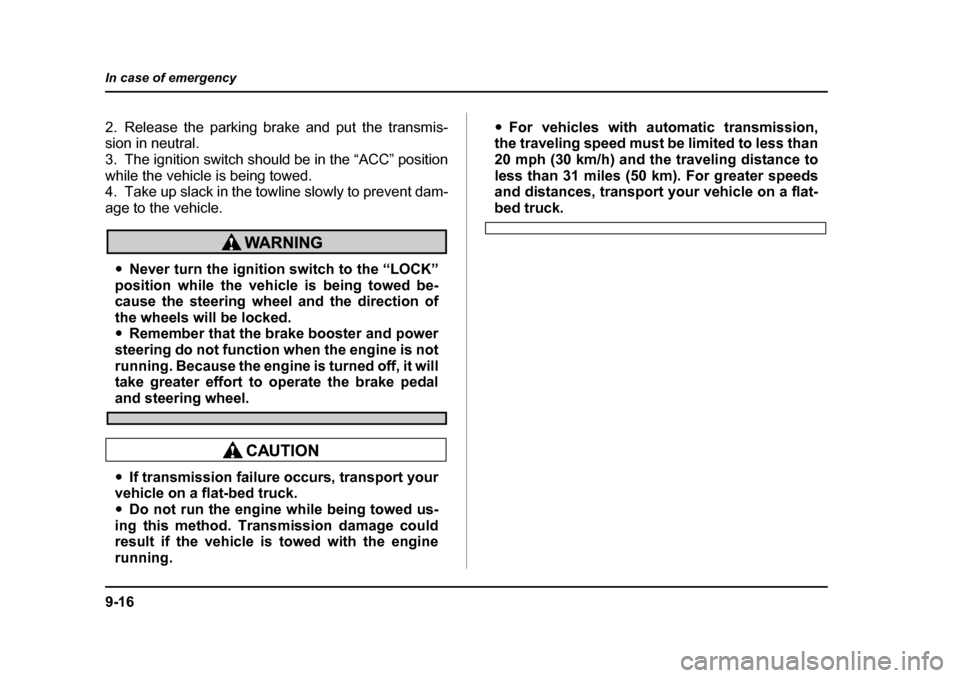Page 340 of 477

9-3
In case of emergency
– CONTINUED –
Flat tires
If you have a flat tire while driving, never brake sud-
denly; keep driving straight ahead while gradually re-
ducing speed. Then slowly pull off the road to a safe
place. �„Changing a flat tire
�yDo not jack up the vehicle on an incline or a
loose road surface. The jack can come out of
the jacking point or sink into the ground and
this can result in a severe accident.�y Use only the jack provided with your vehicle.
The jack supplied with the vehicle is designed
only for changing a tire. Never get under the ve-
hicle while supporting the vehicle with this jack. �y Always turn the engine off before raising the
flat tire off the ground using the jack. Never
swing or push the vehicle supported with the
jack. The jack can come out of the jacking point
due to a jolt and this can result in a severe acci-
dent. 1. Park on a hard, level surface, whenever possible,
then stop the engine.
2. Set the parking brake securely and shift a manual
transmission vehicle in reverse or an automatic trans-
mission vehicle in the “P” (Park) position.
3. Turn on the hazard warning flasher and have ev-
eryone get out of the vehicle.
4. Put wheel blocks at the front and rear of the tire di-
agonally opposite the flat tire.
HS9003BA
Page 353 of 477

9-16
In case of emergency
2. Release the parking brake and put the transmis-
sion in neutral.
3. The ignition switch should be in the “ACC” position
while the vehicle is being towed.
4. Take up slack in the towline slowly to prevent dam-
age to the vehicle.
�y
Never turn the ignition switch to the “LOCK”
position while the vehicle is being towed be-
cause the steering wheel and the direction of
the wheels will be locked.�y Remember that the brake booster and power
steering do not function when the engine is not
running. Because the engine is turned off, it will
take greater effort to operate the brake pedal
and steering wheel.
�y If transmission failure occurs, transport your
vehicle on a flat-bed truck. �y Do not run the engine while being towed us-
ing this method. Transmission damage could
result if the vehicle is towed with the engine
running. �y
For vehicles with automatic transmission,
the traveling speed must be limited to less than
20 mph (30 km/h) and the traveling distance to
less than 31 miles (50 km). For greater speeds
and distances, transport your vehicle on a flat-
bed truck.
Page 366 of 477

11 - 1
11
Maintenance and service
Maintenance schedule ................................. 11-3
Maintenance precautions ............................ 11-3 Before checking or servicing in the engine compartment .................................................. 11-4
When you do checking or servicing in the engine compartment while the engine is
running ............................................................ 11-5
Engine hood .................................................. 11-5
Engine compartment overview ................... 11-8 Non-turbo models ............................................. 11-8
Turbo models .................................................... 11-9
Engine oil ...................................................... 11-10 Checking the oil level ....................................... 11-10
Changing the oil and oil filter .......................... 11-11
Recommended grade and viscosity ................ 11-13
Recommended grade and viscosity under severe driving conditions .............................. 11-15
Synthetic oil ....................................................... 11-15
Cooling system ............................................. 11-16 Cooling fan, hose and connections ................ 11-16
Engine coolant .................................................. 11-17
Air cleaner element ...................................... 11-21 Replacing the air cleaner element ................... 11-21
Spark plugs ................................................... 11-25 Recommended spark plugs ............................. 11-26
Drive belts ..................................................... 11-26
Manual transmission oil ............................... 11-27 Checking the oil level ....................................... 11-27
Recommended grade and viscosity ................ 11-28 Automatic transmission fluid ...................... 11-29
Checking the fluid level .................................... 11-29
Recommended fluid ......................................... 11-31
Front differential gear oil (AT vehicles) ...... 11-31 Checking the oil level ....................................... 11-31
Recommended grade and viscosity ............... 11-32
Rear differential gear oil ............................... 11-33 Checking the gear oil level .............................. 11-33
Recommended grade and viscosity ............... 11-34
Power steering fluid ...................................... 11-34 Checking the fluid level .................................... 11-34
Recommended fluid ......................................... 11-35
Brake fluid ..................................................... 11-36 Checking the fluid level .................................... 11-36
Recommended brake fluid ............................... 11-36
Clutch fluid (MT vehicles) ............................ 11-37 Checking the fluid level .................................... 11-37
Recommended clutch fluid .............................. 11-37
Brake booster ................................................ 11-38
Brake pedal .................................................... 11-38 Checking the brake pedal free play ................ 11-38
Checking the brake pedal reserve distance ... 11-39
Clutch pedal (MT vehicles) ........................... 11-39 Checking the clutch function .......................... 11-39
Checking the clutch pedal free play ............... 11-40
Hill holder (MT vehicles – if equipped) ....... 11-40
Replacement of brake pad and lining ......... 11-41 Breaking-in of new brake pads and linings .... 11-41
Parking brake stroke .................................... 11-42
Page 373 of 477
11 - 8
Maintenance and service
Engine compartment overview �„
Non-turbo models
13 12 11 10 9 8 23
5
46
17USB102BB
1) Air cleaner element (page 11-
21)
2) Manual transmission oil level gauge (MT) (page 11-27) or Dif-
ferential gear oil level gauge
(AT) (page 11-31)
3) Clutch fluid reservoir (page 11-
37)
4) Automatic transmission fluid lev- el gauge (page 11-29)
5) Brake fluid reservoir (page 11- 36)
6) Windshield washer tank (page
11-50)
7) Fuse box (page 11-60)
8) Battery (page 11-58)
9) Engine coolant reservoir (page 11-16)
10) Engine oil filler cap (page 11-10)
11) Engine oil level gauge (page 11- 10)
12) Radiator cap (page 11-16)
13) Power steering fluid reservoir (page 11-34)
Page 374 of 477
11 - 9
Maintenance and service
– CONTINUED –
�„Turbo models
1
23 5
467
8
9
10
11
12
13
USB101BB
1) Manual transmission oil level
gauge (MT) (page 11-27) or Dif-
ferential gear oil level gauge
(AT) (page 11-31)
2) Air cleaner element (page 11- 21)
3) Clutch fluid reservoir (page 11-
37)
4) Automatic transmission fluid lev- el gauge (page 11-29)
5) Brake fluid reservoir (page 11- 36)
6) Windshield washer tank (page
11-50)
7) Fuse box (page 11-60)
8) Battery (page 11-58)
9) Engine oil filler cap (page 11-10)
10) Engine coolant reservoir (page 11-16)
11) Engine oil level gauge (page 11- 10)
12) Radiator cap (page 11-16)
13) Power steering fluid reservoir (page 11-34)
Page 394 of 477

11 -2 9
Maintenance and service
– CONTINUED –
SAE viscosity No. and applicable temperature
Automatic transmission fluid �„Checking the fluid level
The automatic transmission fluid expands largely as
its temperature rises; the fluid level differs according to
fluid temperature. Therefore, there are two different
scales for checking the level of hot fluid and cold fluid
on the dipstick.
Though the fluid level can be checked without warm-
ing up the fluid on the “COLD” range, we recommend
checking the fluid level when the fluid is at operating
temperature. �T Checking the fluid level when the fluid is hot
Check the fluid level monthly.
1. Drive the vehicle several miles to raise the temper-
ature of the transmission fluid up to normal operating
temperature; 154 to 176 °F (70 to 80 °C) is normal.
2. Park the vehicle on a level surface and set the park-
ing brake.
3. First shift the selector lever in each position. Then
shift it in the “P” position, and run the engine at idling
speed.-30 -20 -10 0 10 20 30 40
-20 0 60 20
80W
75W/90 80 100
40
85W 90
HSB036BA
Page 395 of 477
11 - 3 0
Maintenance and service
A) Yellow handle
A) HOT range
B) COLD range
C) Upper level
D) Lower level
4. Pull out the dipstick and check the fluid level on the
gauge. If it is below the lower level on the “HOT”
range, add the recommended automatic transmission
fluid up to the upper level. �T Checking the fluid level when the fluid is cold
When the fluid level has to be checked without time to
warm up the automatic transmission, check to see that
the fluid level is between the lower level and upper lev-
el on the “COLD” range. If it is below that range, add
HSB018MC
ALF
LF
C D
CD B
A
HGB061BC
Page 396 of 477
11 -3 1
Maintenance and service
– CONTINUED –
fluid up to the upper level. Be careful not to overfill. �„Recommended fluid
“Dexron III” Type Automatic Transmission Fluid Front differential gear oil (AT vehi-
cles) �„
Checking the oil level
A) Yellow handle
Check the differential oil level monthly.
1. Park the vehicle on a level surface and stop the en-
gine.
2. Pull out the dipstick, wipe it clean, and insert it
again.
HSB018FC
A